Xiaomi Mi 11i Review – Design And Build Quality Of Xiaomi Mi 11i
The May 11th Is The Main Competitor To The Galaxy S20 FE 5G With Its Powerful Snapdragon 888 Chip And Quasi-Flagship Camera Set.
Xiaomi Mi 11i, Until recently, in response to those looking for a smartphone in the price range of 15 million tomans, we immediately introduced the 5G version of the Galaxy S20 FE; But now it seems that Samsung’s economic flagship is no longer unrivaled. The Mi 11i is Xiaomi’s new representative in this price range; A smartphone that, as its name suggests, combines Chinese flagship DNA with their intermediate and economical products.
Xiaomi May 11 does not have its flagship brother’s flashy QHD curved display, metal frame, and giant camera. Still, it uses the same powerful Snapdragon 888 chip, has a glass body, and uses a quality OLED display. Is the Mi 11i the best economic flagship on the market?
Design and build quality of Xiaomi Mi 11i
From flagships like the Mi 11 to the Redmi Note 10’s economy device, and of course the Mi 11i we’re looking at, most of Xiaomi’s 2020-2021 products have a lot in common; The similarities, more than anything else, stem from the relatively large steps of the camera in the corner of the back panel. With such a thick protrusion, Xiaomi is trying to insinuate that its smartphones have an efficient camera; But it has added more to the slipping of the phone while using it on the table!
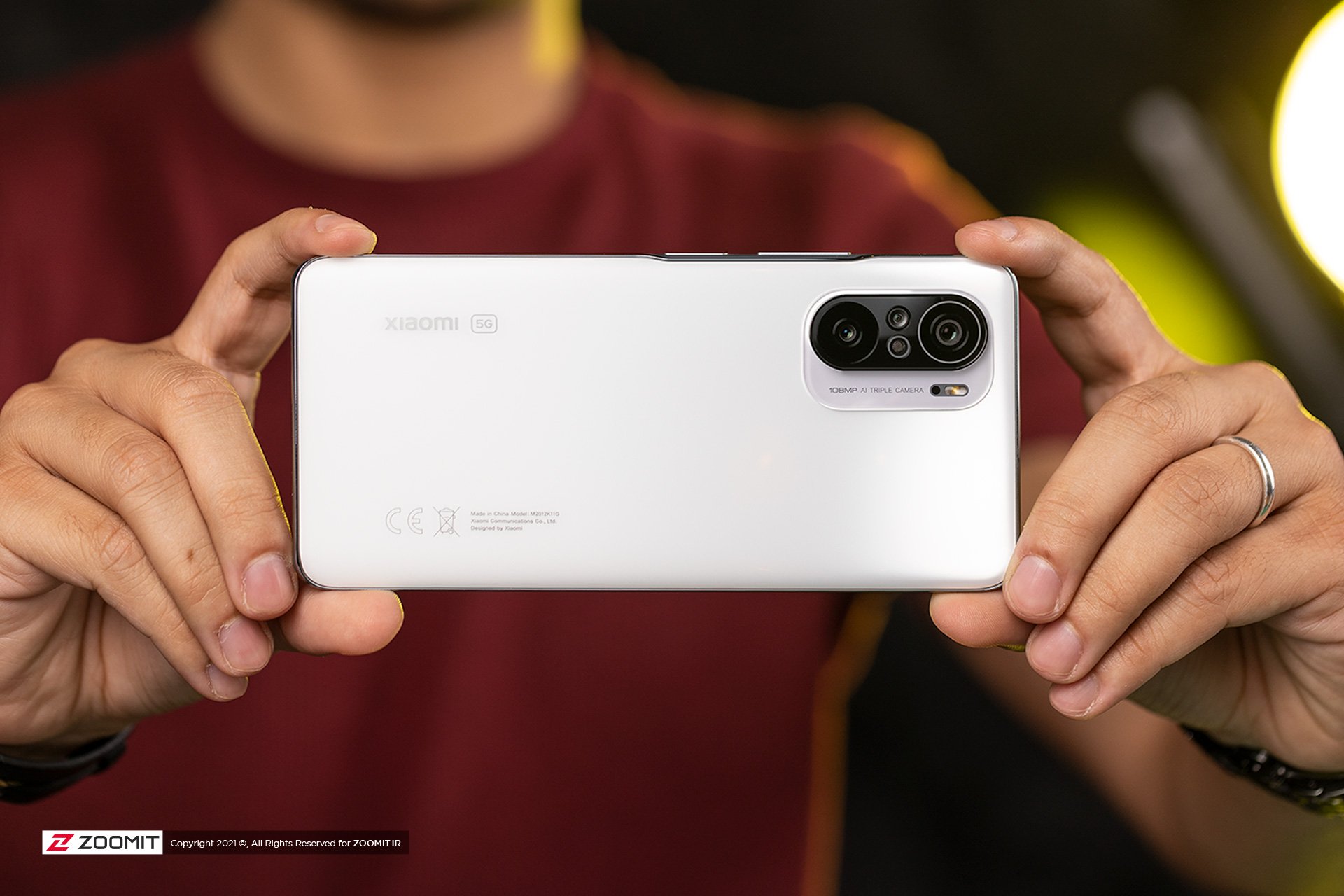
We had the May 11 and Redmi Note 10 Pro available for review at the same time, and we have to say that as long as you don’t look at the rounder corners of the camera protrusion on the Redmi Note 10,, Pro, you can hardly separate the two phones. F3 does not cut hair either! The May 11 and Redmi Note 10 Pro are also very similar in size and weight. Dimensions May 11 I 7.8 × 76 ٫ 4 × 163.7 mm and weighs 196 grams; Thus, it is not as difficult to use as the 225-gram Poco X3; But again, to access the corners of the screen, you have to move the device manually.
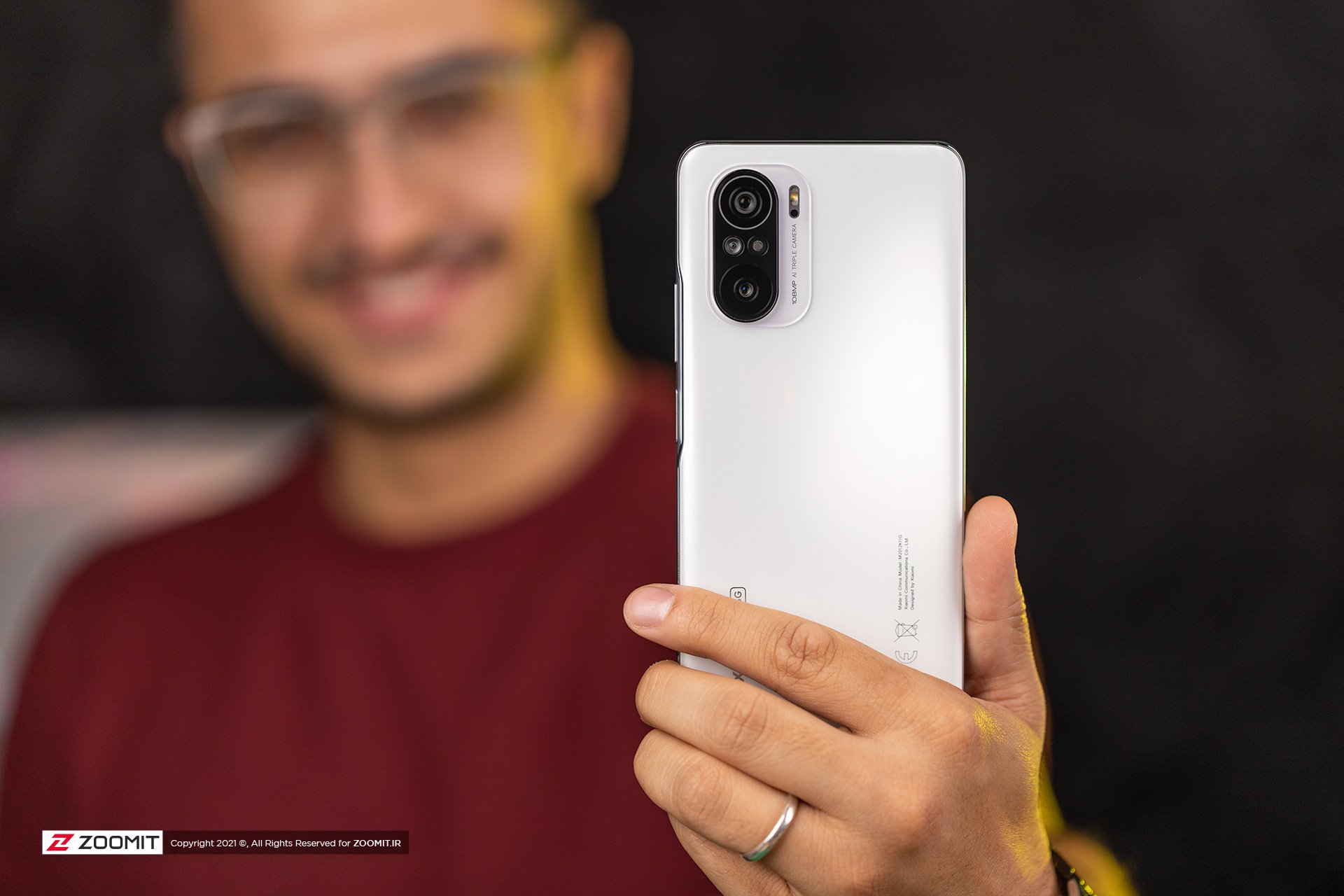
Xiaomi says the front and back panels of the May 11i are made of Gorilla Glass 5, but the device’s frame is plastic. Available on May 11 in matte shell white and silver with a glossy black finish. We had the oyster-white version available for review, which both conveys a delightful feeling to the user and does not show the effects of stains and grease. The May 11i white color has a smooth yet soft coating on its surface, the equivalent of which we have already experienced in some other devices such as the Poco F3.
The 6.67-inch May 11I display, with its slim bezel (except for the bottom bezel!) And flat edges sit behind the Gorilla Glass 5 glass and account for nearly 86 percent of the phone’s front. The presence of a plastic strip between the display and the frame reminds us of the economic nature of the Mi 11i, like other low-cost devices. The Chinese have placed the selfie camera in small holes in the screen, and unfortunately, there is no notification light at the top of the screen.

Although the display panel is OLED, there is no fingerprint sensor under the display. Instead, the Chinese have integrated the Mi 11i power switch on the right edge of the frame with the fingerprint sensor. Access to the power switch is easy; But definitely during the day, you will often see the phone shake due to accidental touch of the sensor.
The May 11i plastic frame hosts the lower edge of the speaker port, the USB 2.0 Type-C port, and the dual-SIM port (no, not the memory card slot!). At the top edge is an aperture for the top speaker, microphone, and IR Blaster module, so you can use the Mi 11i to control some of your appliances.
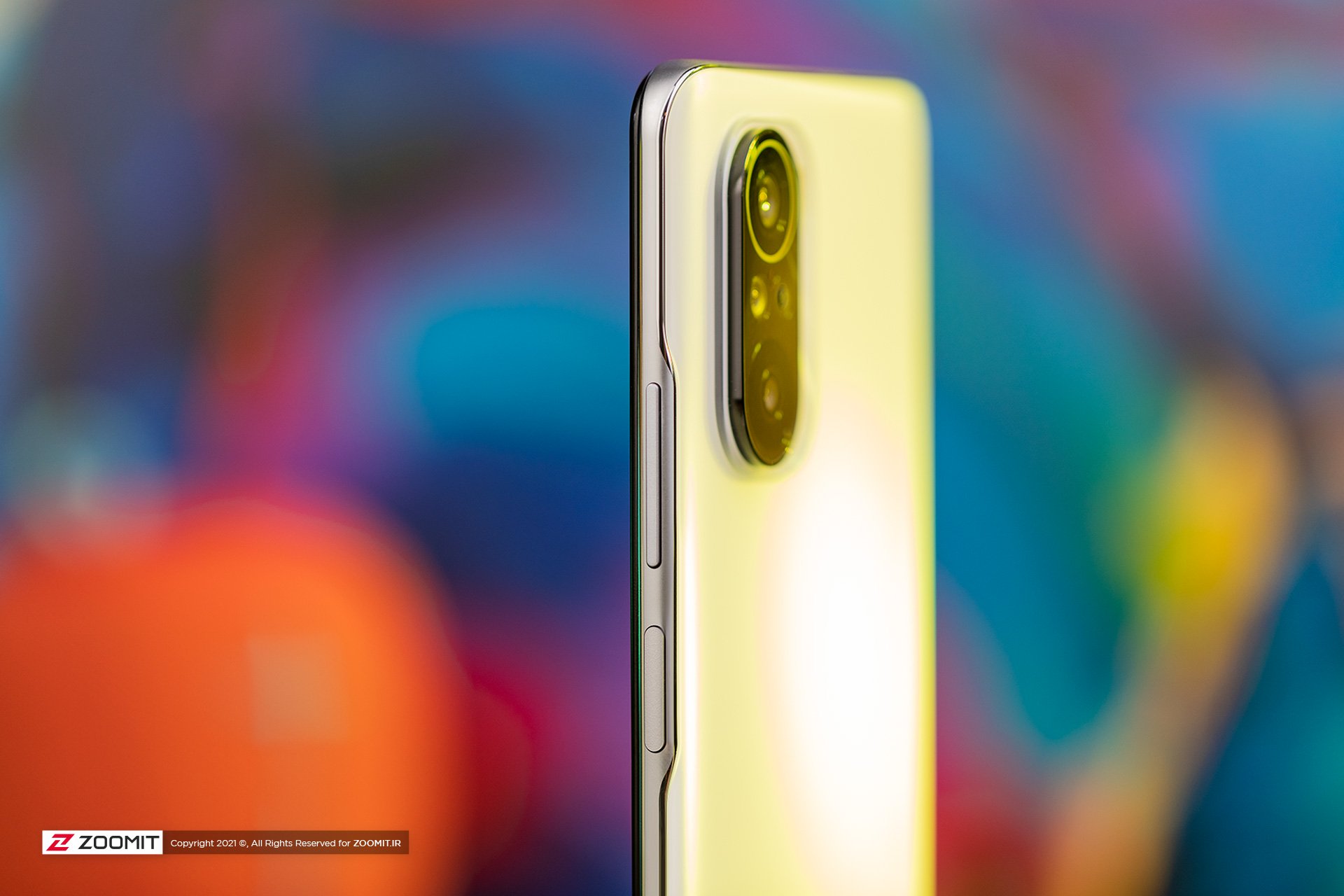
Xiaomi says the Mi 11i is IP53 certified by the IEC and is resistant to dust or water droplets.
Xiaomi Mi 11i display
The display is another part that sets the Mi 11i apart from its more expensive sibling, the Mi 11; This economical flagship uses an AMOLED panel with FHD + resolution or 1080 x 2400 pixels and a pixel density of 395 pixels per inch, which is not as sharp and clear as the 515 pixelbrinch models used in the Mi 11. However, still, it is enough to have a pleasant experience browsing and watching videos.
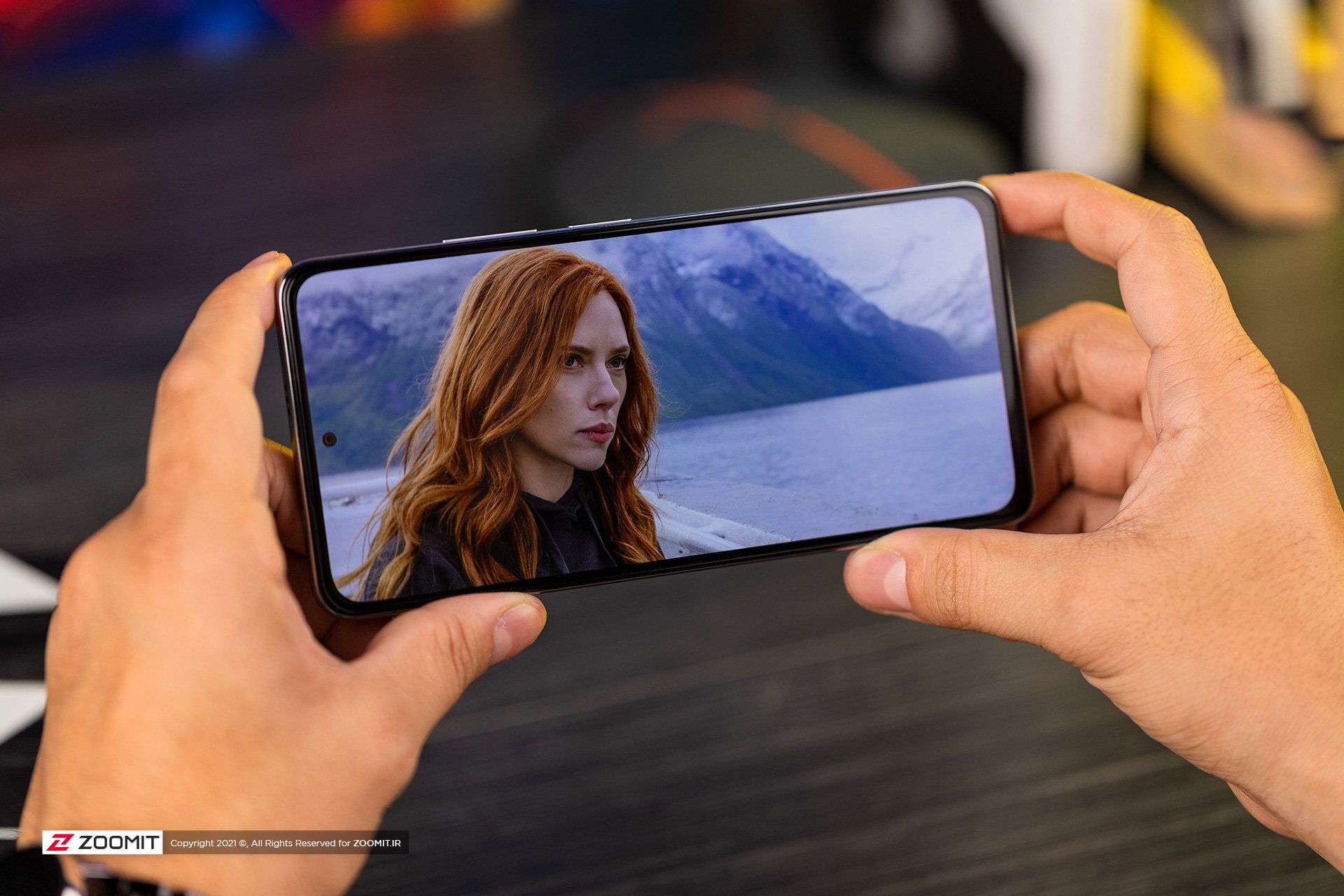
The Mi 11i has a 120Hz refresh rate and a 360Hz touch sensitivity rate; In this way, the device offers a very smooth and smooth user experience, enables the execution of games at a rate of up to 120 frames per second, and in competitive games, responds very quickly to the user’s touch commands.
Xiaomi calls the May 11 refurbishment rate adaptable; But in practice, we only see that in many apps like Google Photos or even games like PUBG and CoD, the refresh rate stays at a constant 60 Hz and reaches 120 Hz when you touch the screen. May 11 In some environments, such as the list of recent apps or video playback in image mode, the display’s refresh rate reaches 90 Hz.
The Chinese speak with great confidence about the May 11 screen; According to Xiaomi, the company’s economic flagship, “received an A + rating from DisplayMate, displays colors with great accuracy, has 100% coverage of DCI-P3 color space, reaches a brightness of 1300 nits, and with HDR10 + standard. “It is compatible.”
| Xiaomi Mi 11i display performance against competitors | ||||||||
|---|---|---|---|---|---|---|---|---|
| Product ام Parameters | Minimum brightness | Maximum manual brightness | Maximum automatic brightness | Native contrast ratio | Average color error | |||
| White | Black | White | Black | White | Default mode | The most accurate mode | ||
| Xiaomi Mi 11i | 1.5 | ۰ | 563 | ۰ | 830 | ∞ | 3.6 (Auto) | 1 (Original Color) |
| Galaxy S21 | 2.2 | ۰ | 675 | ۰ | 1115 | ∞ | 5 (Vivid) | 3.3 (Natural) |
| Galaxy S20 FE | 2.2 | ۰ | 608 | ۰ | 1270 | ∞ | 4.6 (Vivid) | 2.2 (Natural) |
| iPhone 12 | ۲ | ۰ | 765 | ۰ | 763 | ∞ | 1.3 (sRGB space) | 1.3 (sRGB space) |
| Xiaomi May 10 | 3.3 | ۰ | 930 | ۰ | 1650 | ∞ | 2.6 | 1.9 (Original) |
All the results obtained from Zomit tests are in the same laboratory conditions.
The Xiaomi Mi 11i, like most Xiaomi phones, offers a lot of modes for display color settings, most of which are confusing:
- Auto mode: In this mode, the colors of the screen change according to the ambient light.
- Original mode: The natural mode, which according to Xiaomi, shows the most accurate colors.
- Saturated mode: In this mode, saturated colors are displayed.
- Advanced mode: In this mode, you can access special color profiles:
- Enhanced mode: The widest color gamut is displayed, regardless of ambient light or display content.
- Original mode: The colors of the screen are calibrated based on the content of the phone.
- Mode P3: DCI-P3 color gamut is always displayed, regardless of ambient light or display content.
- SRGB mode: sRGB color gamut is always displayed, regardless of ambient light or display content.
Since Advanced modes are not important to most users, we also checked the display performance in only three modes: Original, Auto, and Saturated. In Auto mode, the DCI-P3 color spectrum is completely covered, and the color error is acceptable; But colors have a great tendency to be cold. The saturated model has more or less the same function as Auto mode. Still, the Original mode completely covers the sRGB color spectrum and has excellent color accuracy and perfect temperature. If color accuracy is important to you, you just have to do so use the Original mode.
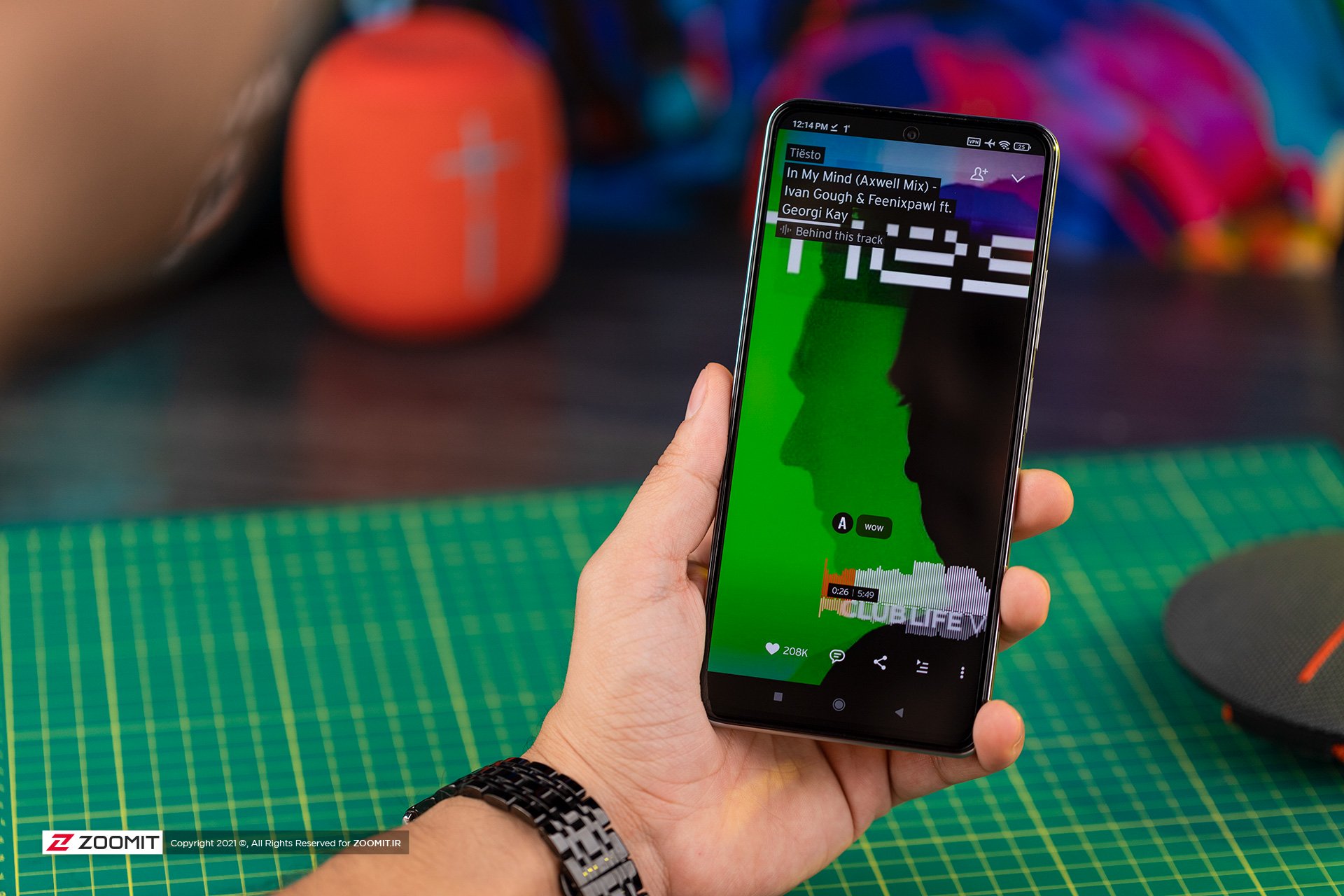
Xiaomi’s flagship economy achieved a maximum brightness of 563 and 830 nits in manual and automatic modes in our light meter test; Therefore, the device is very readable in sunlight; But there is no market at the best level.
Xiaomi Mi 11i software and user interface
Xiaomi’s flagship economy sells the latest version of the Chinese proprietary user interface by default with Android 11 and MIUI 12.5. Aside from Xiaomi and Google proprietary software, there are a few miscellaneous apps, including NETFLIX and a few games installed on the Xiaomi Mi 11I, that you can easily remove.

Xiaomi has introduced new features in MIUI 12.5 that may seem small, But they can improve the user experience. For example, MIUI in the new version is faster, lighter, and more stable, and its rendering power is improved 20 times. On the other hand, the design of visual capabilities has been improved so that the user has a more realistic experience while working with the phone. Other features for customizing system sounds and animated wallpapers have been added to the new version of MIUI called “Super Wallpaper.”
Hardware, gaming experience, and Xiaomi Mi 11i battery
Undoubtedly the strong point of May 11 returns to its chip; The beating heart of Xiaomi’s flagship economy, the Snapdragon 888, is the most powerful chip in the Android world today. The module is manufactured with Samsung 5-nanometer 5LPE lithography and, according to Qualcomm, provides a 25% improvement in CPU performance and a 35% improvement in GPU performance compared to the Snapdragon 865.

Before any other chip, the Snapdragon 888 was equipped with the powerful new Cortex-X1 and Cortex-A78 cores. The chip uses a combination of a 2.84 GHz Cortex-X1 core, three 2.42 GHz Cortex-A78 mid-core cores, and four low-power 1.80 GHz Cortex-A55 cores as the CPU.
The Adreno 660 module is responsible for graphics processing on the Snapdragon 888 chip. Qualcomm does not provide much information about the details and specifications of the GPU. Still, it says the Adreno 660 is 43 percent better at AI-related processing, 35 percent at graphics processing, and 20 percent better at productivity (same performance as before).
| Technical specifications of Snapdragon 888 chip against competitors | |||
|---|---|---|---|
| Specifications / Chips | Exynos 2100 | Snapdragon 888 | Apple A14 |
| CPU | A 2.9 GHz Cortex-X1 3-core 2.8 GHz Cortex-A78 4-core 2.2 GHz Cortex-A55 |
A 2.84 GHz Cortex-X1 Core with 1MB L2 Cache 3 2.42GHz Cortex-A78 Core with 512KB L2 Core 1.80GHz Cortex-A55 Each with 128KB L2 4MB Cache 8 cores |
Dual-core 3 GHz Firestorm with 8MB L2 cores 1.8GHz Icestorm |
| GPU | Mali G78MP14 | Adreno 660 | Apple 4-core module |
| Memory controller | LPDDR5 | 4 16-bit channels, 3 MB system cache 51.2 GB bandwidth with 3200MHz LPDDR5 RAM |
64-bit bus, 16 MB LPDDR4x RAM system cache |
| ISP | A 200-megapixel camera at the same time | A 200-megapixel camera at the same time | – |
| NPR | Triple NPU with DSP for a total of 26 trillion operations per second | CPU, GPU, and DSP for a total of 26 trillion operations per second | 16-core neural motor with 11 trillion operations per second |
| Uncode / Decode | 8K30 or 4K120 code and 8K60 code with H.265, VP9, and AV1 codecs | Encode and decode 8K30 or 4K120 with 10-bit H.265 codec | Encode and decode with 10-bit H.265 codec and VP9 decode with AV1 codec |
| Modem | 5G integrated modem LTE download and upload up to 3000 and 422 Mbps download and upload 5G up to 7350 and 3670 Mbps |
5G integrated modem LTE download and upload up to 2500 and 316 Mbps Download and upload 5G up to 7500 and 3000 Mbps |
5G modem download up to 3500 Mbps |
| The manufacturing process | 5 nm Samsung LPE | 5 nm Samsung LPE | 5 nm EUV TSMC |
An important point about the Adreno 660 goes back to the addition of variable rate shading. This feature previously added to ninth-generation consoles allows the developer to shade less important areas of the game’s frames with less detail, thus deploying GPU processing power to more important areas of the frames.
Qualcomm says the new Hexagon 780 Digital Signal Processor (DSP) is undergoing changes such as the integration of scalar, vector, and tensor accelerators, and now, along with the CPU and GPU, can perform 26 trillion AI-computed operations per second; Thus, the computing power of Snapdragon 888 is 73 times higher than Snapdragon 865.
Thanks to its triple image signal processor (ISP), the Snapdragon 888 is now capable of instant photography with three 28-megapixel sensors or simultaneous video recording of three 4K HDR videos. Qualcomm’s flagship chip can also record and play 10-bit 8K30 and 4K120 videos with the H.265 codec and Dolby Vision, HDR10 +, HDR10, and HLG standards.
The flagship Snapdragon 888 chip also supports 5G networks with download and upload speeds of 7500 and 3000 Mbps, thanks to the X60 modem.
| Xiaomi Mi 11i memory performance against competitors | ||||
|---|---|---|---|---|
| Models ٫ Performance | Sequential reading rate (MB / s) |
Sequential write rate (MB / s) |
Random reading rate (MB / s) |
Random writing rate (MB / s) |
| Xiaomi Mi 11i | 1514. 61 | 589. 81 | 183. 31 | 201. 13 |
| Galaxy S21 | 1906. 68 | ۱۳۳۱ ۰ ۰۲ | 309. 33 | 290. 29 |
| Galaxy S20 FE | 1572.95 | 674. 77 | 199. 44 | 236. 32 |
| Xiaomi May 10 | 1374. 36 | 649. 45 | 213. 82 | 217. 41 |
* All benchmarks mentioned in this table have been implemented by Limit.
Xiaomi’s flagship economy phone and the Snapdragon 888 feature 8GB of LPDDR5 RAM and 128GB or 256GB of high-speed UFS 3.1 memory. Since there is no memory card slot; Therefore, we recommend that you prepare the appropriate May 11i model, depending on your needs.
May 11’s Compared to May 10T, Xiaomi’s older economic flagship with the Snapdragon 865 chip experiences a 10% improvement in CPU-based performance, which is lower than Qualcomm’s 25% claim. Still, in terms of graphics, we see a significant improvement, the Mi 11i with the Snapdragon 888 chip shows more than 45% more computing power in the GeekBench benchmark.
| Xiaomi Mi 11i performance against competitors | |||||||||
|---|---|---|---|---|---|---|---|---|---|
| Name and performance of the benchmark/product | PCMark | Speedometer 2.0 | GeekBench 5 | GFXBench | |||||
| Overall performance | browser | GPU | CPU | Game simulator (frame rate) | |||||
| OpenCL Volcano / Metal |
Single Core Multi-Core |
Aztec Ruins Onscreen / 1440p |
Car Chase Onscreen / 1080p |
||||||
| OpenGL | Volcano | Metal | OpenGL | Metal | |||||
| Xiaomi Mi 11i (120Hz) |
12944 | 112 | 4650 4322 |
1135 3694 |
40 27 |
44 30 |
– | 57 67 |
– |
| Galaxy S21 (Adaptive) |
14191 | 89.8 | 6473 5596 |
1070 3343 |
41 27 |
37 29 |
– | 51 62 |
– |
| iPhone 12 | – | 193.3 | – 9233 |
1613 3997 |
– | – | 49.9 32.1 |
– | 52.3 70.9 |
| Poco F3 (120 Hz) |
10213 | 66.8 | 3563 3471 |
973 3281 |
32 20 |
33 21 |
– | 47 52 |
– |
| Galaxy S20 FE (120Hz) |
12044 | 62.4 | 4496 3978 |
924 2751 |
31 22 |
18 20 |
– | 40 47 |
– |
| Xiaomi Mi 10T (144Hz) |
9664 | 65.2 | 3169 3095 |
907 3319 |
29 20 |
29 20 |
– | 44 51 |
– |
| Xiaomi Mi 10 | 8686 | 45.2 | – | 657 1982 |
21 7.4 |
23 7.6 |
– | 33 19 |
– |
* All benchmarks mentioned in this table have been implemented.
Utilizing the powerful Snapdragon 888 chip, Xiaomi’s flagship player runs both PUBG Mobile and Call of Duty Mobile at 60Hz refresh rate; Accordingly, our experiments show that PUBG does not exceed the rate of about 52 to 60 frames per second, even with medium HD graphics settings. It also ran the popular CoD game with the best graphics settings and a stable 57 to 60 frames per second rate.
| Xiaomi Mi 11i performance in running mobile games | ||
|---|---|---|
| Mobile game title | Graphics settings of the game | Frame rate |
| PUBG Mobile | Ultra HD | 40 to 37 frames per second |
| PUBG Mobile | HD | 60 to 52 frames per second |
| Call of Duty Mobile | Very High | 60 to 57 frames per second |
* All benchmarks mentioned in this table have been implemented by Limit.
May 11 uses a non-bulky battery with a capacity of 4520 mAh to supply the required energy. Xiaomi does not provide exact figures for the Mi 11i charging, But he says the battery of this phone can make you needless of chargers all day.
Xiaomi’s flagship economy is devoid of the expensive brothers’ super-fast charging system, But its 33-watt charger still performs very well. The Mi 11i takes an hour and 20 minutes to charge fully.
| Xiaomi Mi 11i battery performance against competitors | |||||
|---|---|---|---|---|---|
| Product ٫ Test | Display | Battery | Time required to charge | Video playback | PCMark |
| Dimensions and resolution | Million amp-hours | Minutes: hours | Minutes: hours | Minutes: hours | |
| Xiaomi Mi 11i (120Hz) |
6.67 inches 2400 × 1080 pixels |
4520 | 1:20 | 21:31 | 9:50 p.m. |
| Xiaomi Mi 11i (60 Hz) |
6.67 inches 2400 × 1080 pixels |
4520 | – | – | 12:13 |
| Galaxy S21 (Adaptive) |
6.2 inches 2400 × 1080 pixels |
4,000 | – | 18:11 | 8:05 |
| iPhone 12 | 6.1 inches 2532 × 1170 pixels |
2815 | – | 17:50 | – |
| Poco F3 (120 Hz) |
6.67 inches 2400 × 1080 pixels |
4520 | 00:55 | 20:35 | 14:24 |
| Galaxy S20 FE (120Hz) |
6.5 inches 2400 × 1080 pixels |
4500 | – | 14:41 | 8:30 |
| Xiaomi Mi 10T | 6.67 inches 2400 × 1080 pixels |
5000 | 1:00 p.m. | 15:10 | 13:01 |
* All benchmarks mentioned in this table have been implemented.
Phone Xiaomi Mi 11i with 200 nits (slider brightness of approximately 80%) and refresh rate of 120 Hz screen, where all wireless connections and speaker grills and disconnect the video standard Zvmyt HD resolution 21 hours and 31 minutes continuously broadcast Which is an awe-inspiring result. Because the May 11 I in the Google Photos application reduces the refresh rate to 60 Hz, changing the refresh rate settings does not change the video playback time.
The PCMark test, which reflects how long the display stays on in normal applications such as browsing, photo or text editing, and video playback, lasted 9 hours and 50 minutes at 200 nits and 120Hz refresh rate to other competitors. It does not count; But if we reduce the refresh rate to 60 Hz in the same test, the device’s charging will increase to 12 hours and 13 minutes.
Xiaomi Mi 11i camera
Like its flagship Xiaomi Mi 11, its cheaper sibling uses a combination of a “wide + ultraviolet + macro” camera. Even at first glance, it looks like their main camera is the same, and both use a 108-megapixel sensor. Still, with a little care, you can see the stark differences between the cameras.
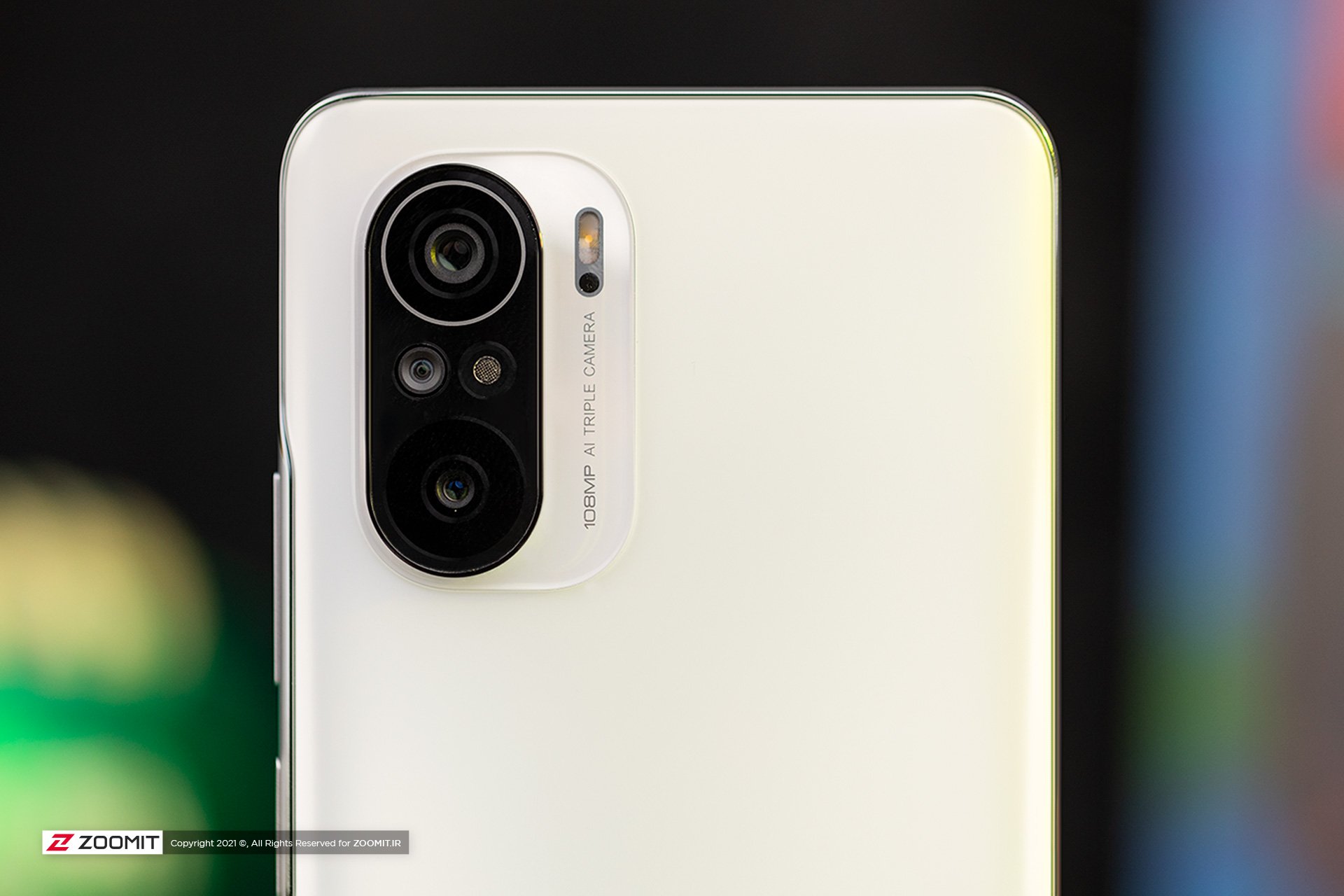
The Mi 11i main camera uses Samsung’s 108-megapixel HM2 sensor with 1.5 / 1-inch dimensions and 0.7-micron pixels and is located behind the wide-angle lens at f / 1.8. Fingerprint calculations show that the HM2 sensor is about 15% smaller than the HM3 used in flagship products such as the Mi 11, and there is no optical image stabilization in the May 11I lens; Thus, the Mi 11i main camera will not be at the level of its flagship brother, either in terms of light sensitivity or photography in the dark.
The May 11i 108-megapixel camera uses the Nonacell color filter instead of the Tetracell filter used in the Mi 11; This means that with every 9 adjacent pixels, one of the three primary RGB colors is recorded so that by default, the camera captures images with a resolution of 12 megapixels and large pixels of 2.1 micrometers. The purpose of using such a filter is to absorb more light and experience improved photography in the dark.
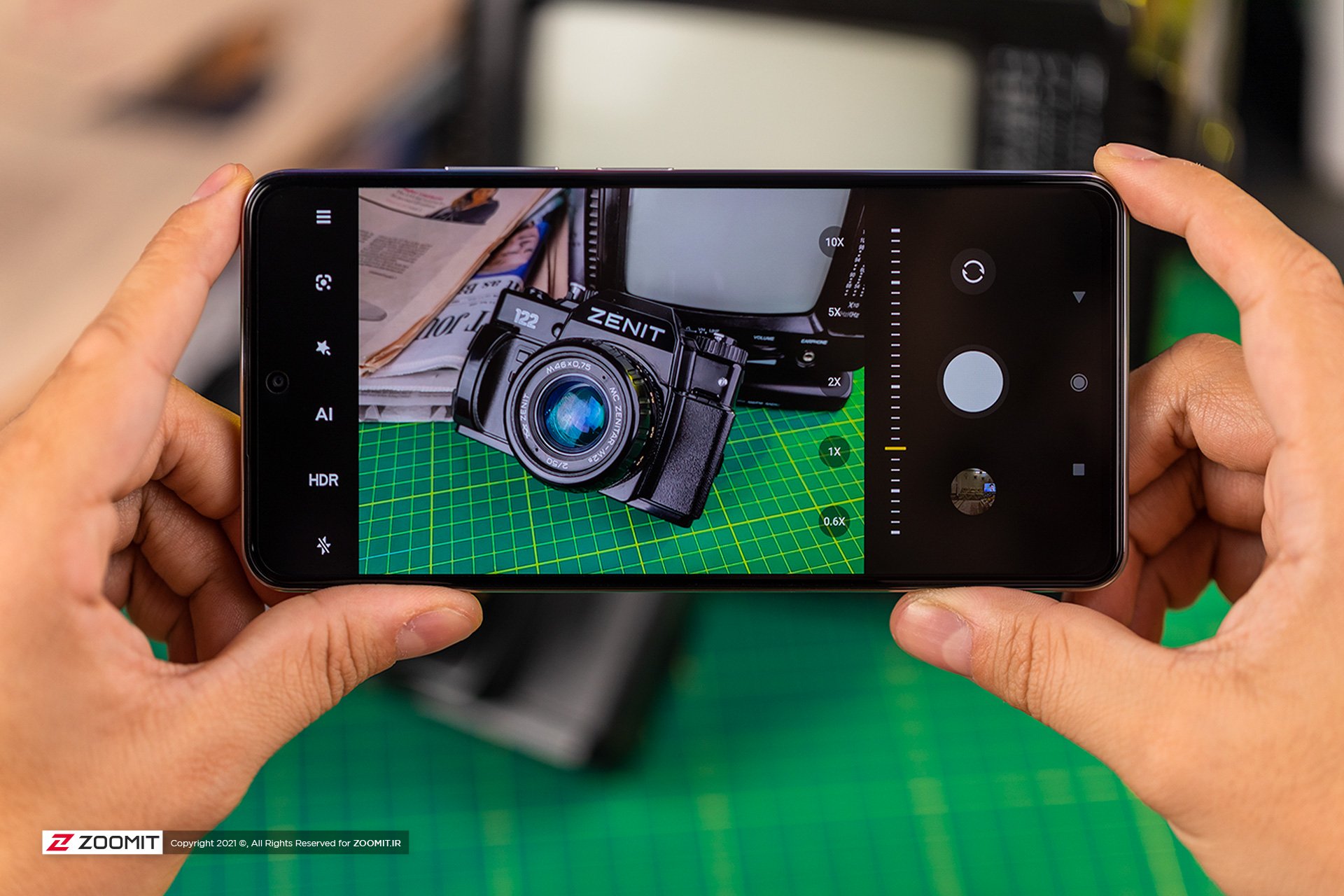
Xiaomi has introduced a 108-megapixel native camera sensor mode for the Mi 11i. HDR and AI capabilities will not be usable. Using 108-megapixel mode in daylight will be effective because the phone has to simulate the performance of a normal Bayer filter on 108-megapixel cameras by approximating the color of the adjacent pixels.
Like the Redmi Note 10 Pro, the Xiaomi Mi 11i uses an 8-megapixel IMX355 sensor with ultra-small 1 / 4.0-inch and 1.12-micron pixels to capture ultra-wide images. This camera has no optical image stabilization or autofocus and uses an ultra-wide lens with a field of view of 118 degrees and an aperture of f / 2.2; For comparison, the Mi 11 uses a much larger 1 / 3.06-inch sensor.
Dynamic range and photo detail of Xiaomi Mi 11i
May 11I Although, like its more economical sibling, the Redmi Note 10 Pro uses the same HM2 sensor in the main camera. It uses the powerful Snapdragon 888 chip to detect subjects very quickly and accurately and implements the HDR algorithm on the image when needed. The basis of its photos in the same conditions and Auto HDR mode has a much wider dynamic range. The Mi 11i performs well in detail processing and noise control.
As you can see in the pictures, the UltraVide camera performs much worse than the May 11I in terms of dynamic range (note the roof and hood of cars), processing the details of complex subjects such as tree branches and noise levels.

HDR photo of the main camera

HDR Photo Ultraviolet Camera
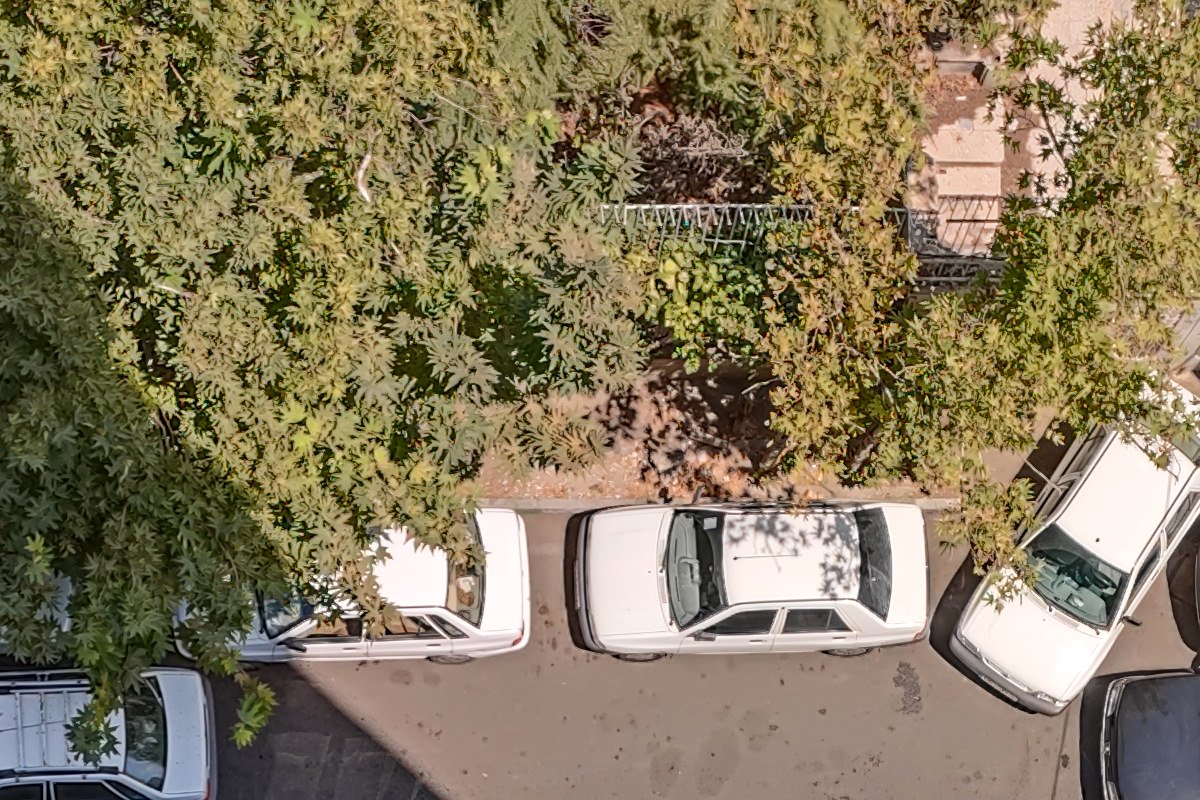
100% cropping of the main camera photo
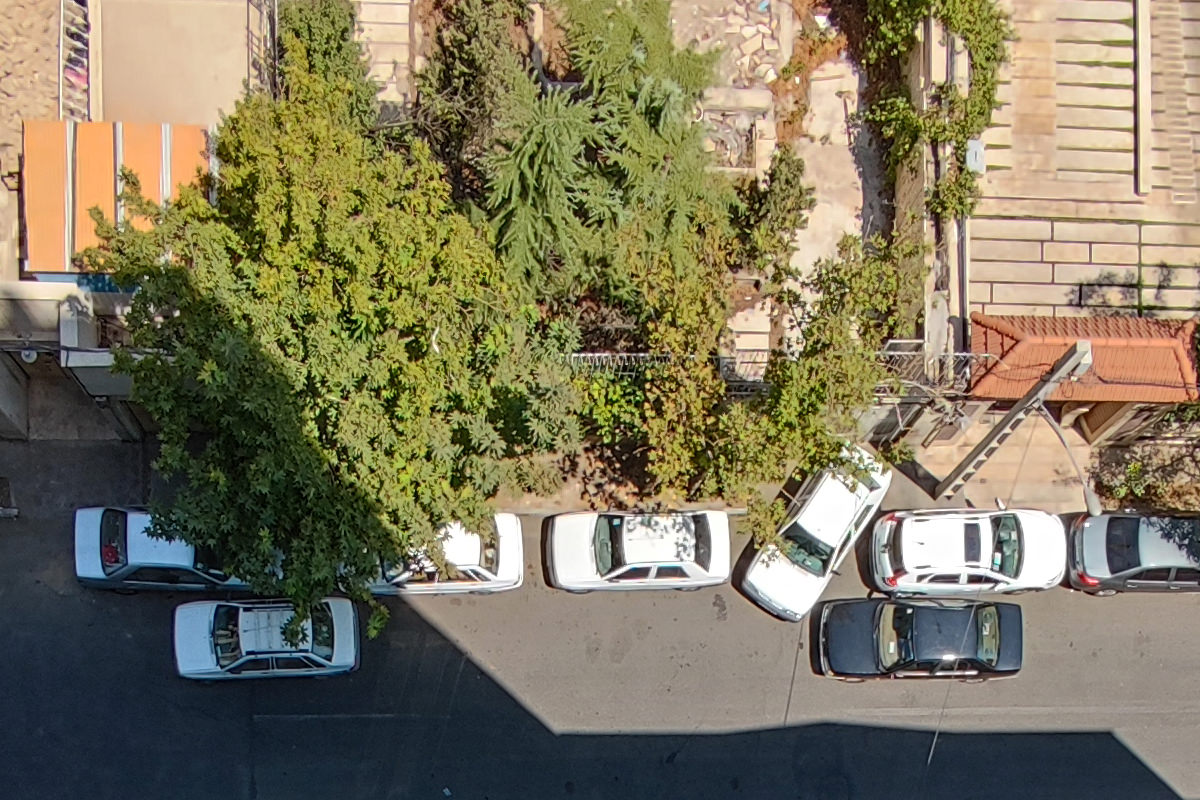
100% cropping of ultraviolet camera photos
Color photos of Xiaomi Mi 11i
The May 11I main camera produces colors that are very close to reality. Still, as you can see in the pictures [note the floor and the leaves of the trees], the ultraviolet camera produces a slightly warmer, relatively saturated color.
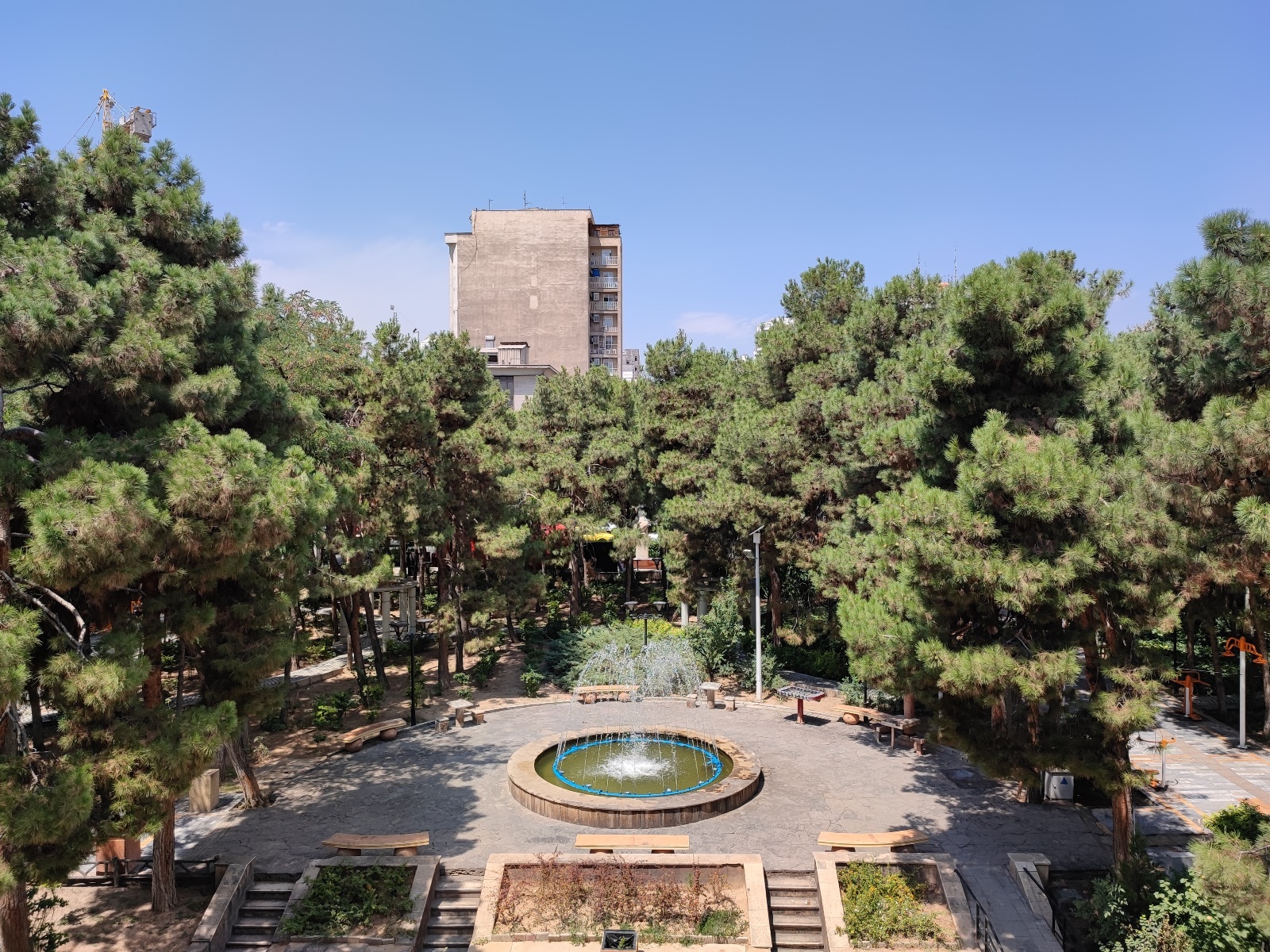
Colors in the main camera image

Colors in the ultraviolet camera photo
108-megapixel photo detail difference and digital zoom
If you do not have a problem with about 20 MB of 108-megapixel photos, in this case, the details of the photos are much more than normal digital magnification [notice the municipality logo on the clock or the leaf of the tree on the back of the clock]. At normal digital zoom, photos are somewhat softer than water, which reduces their detail.
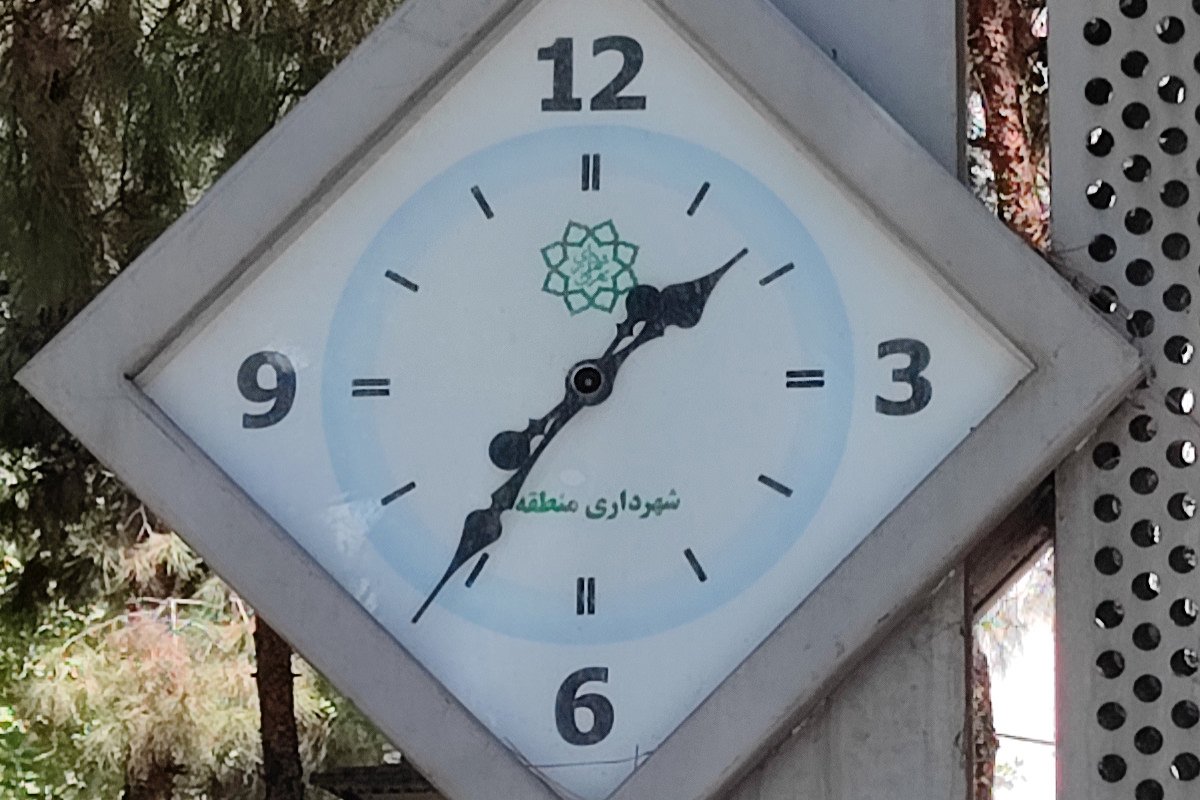
A real slice of 2x digital zoom
![]()
Equivalent cropping of 108-megapixel photos
Xiaomi Mi 11i camera performance in the dark
Main camera
Xiaomi Mi 11i main camera in Photo mode also takes satisfying photos in the dark of night and has a good function in adjusting the exposure of highlights. ; But this attempt to brighten the shadows also leads to the loss of detail in the bright parts of the image [see shop windows inside the building].

Dark photo of the main camera with Photo mode

Dark photo of the main camera with Night mode
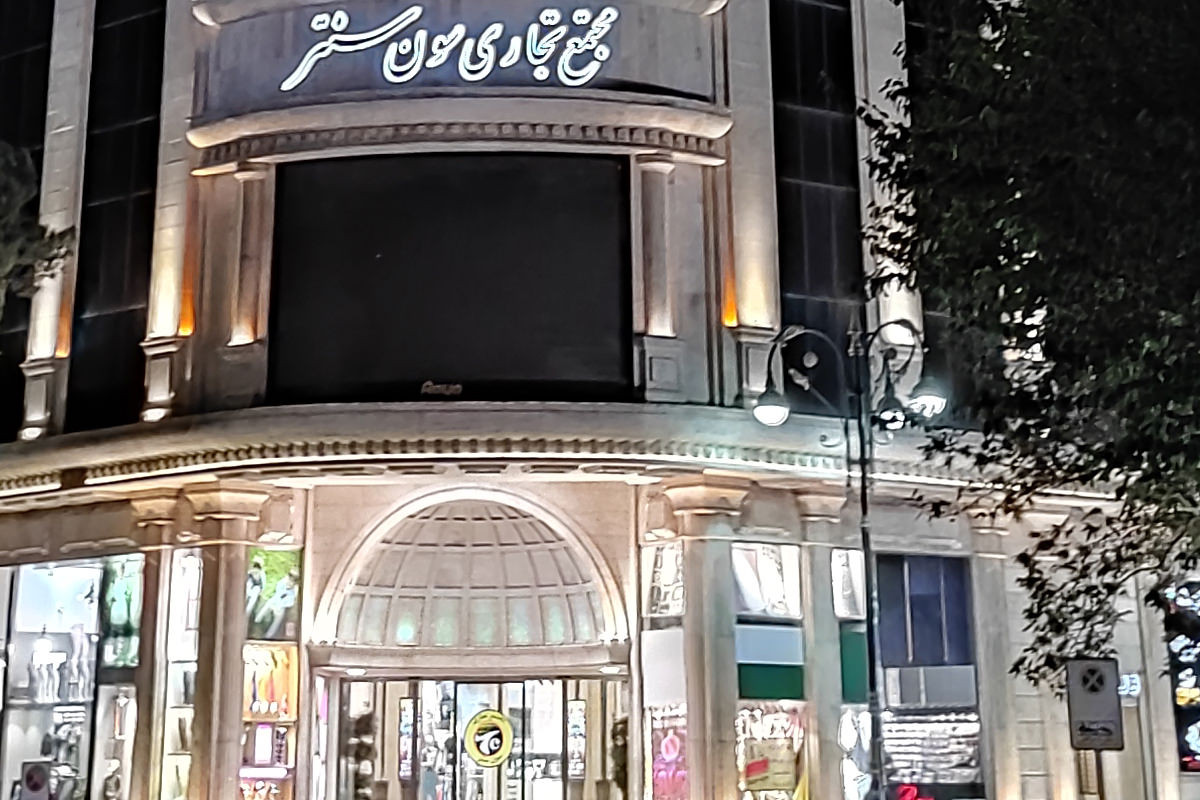
100% cropping of the main camera photo with Photo mode
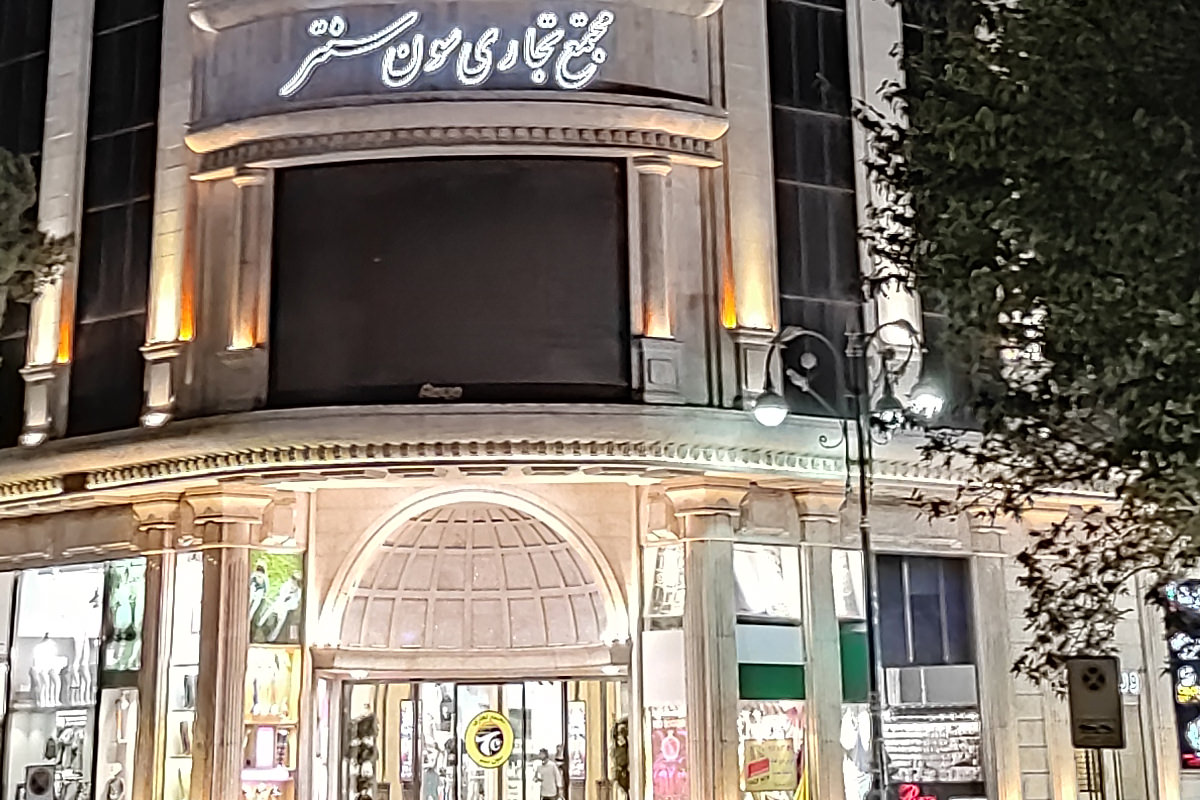
100% cropping of the main camera photo with Night mode
Ultraviolet camera
The May 11I Ultraviolet Camera captures catastrophic photos in the dark with burnt highlights and shadows of darkness. Using Night mode does not work miracles, But it diminishes the depth of the tragedy a little.

Ultraviolet camera dark photo with Photo mode

Ultraviolet camera dark photo with Night mode

100% cropping of ultraviolet camera photo with Photo mode

100% cropping of Ultraviolet camera photo with Night mode
Portrait and selfie photos of Xiaomi Mi 11i
The May 11 relies on Samsung’s 20-megapixel 1 / 3.4-inch sensor with 0.8-micrometer pixels and a wide-angle f / 2.5 lens for taking selfies. None of the main and selfie cameras have an interesting and precise function in separating the subjects from the background and implementing the bokeh effect. On the other hand, the dynamic range in the photos is minimal [note the missing details in the windows]. Apart from the above, they are soft portrait photos.

Portrait
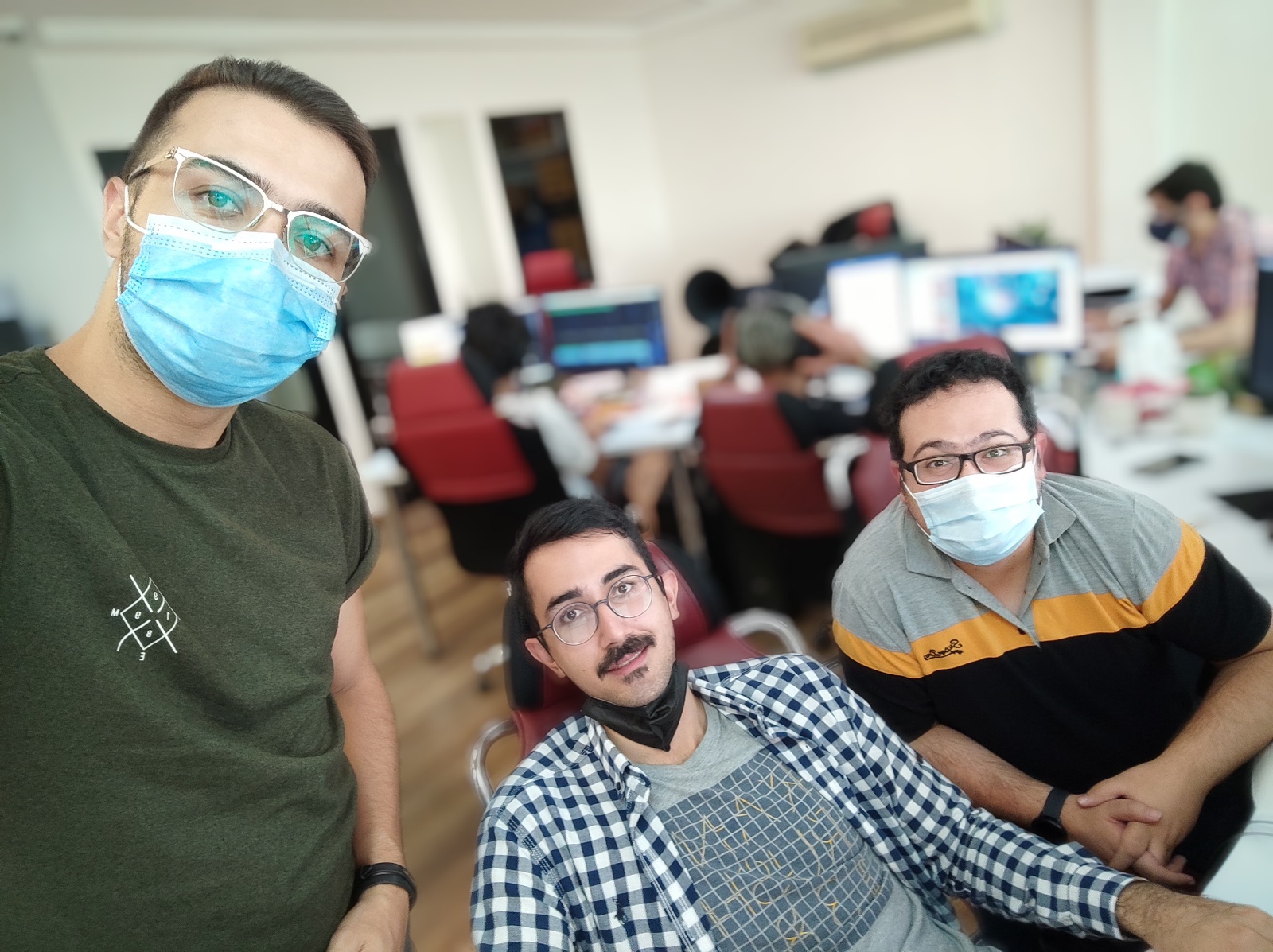
Selfie photo
Macro photo of Xiaomi Mi 11i
The May 11 uses a 5-megapixel camera with a 50mm lens, f / 2.4 aperture, and autofocus for macro photography. The macro camera can focus on the subject at a distance of 3 to 7 cm, and its depth of field is minimal; Thus, in the narrow range of focus, the subject is captured in great detail, and many parts of the image are blurred.
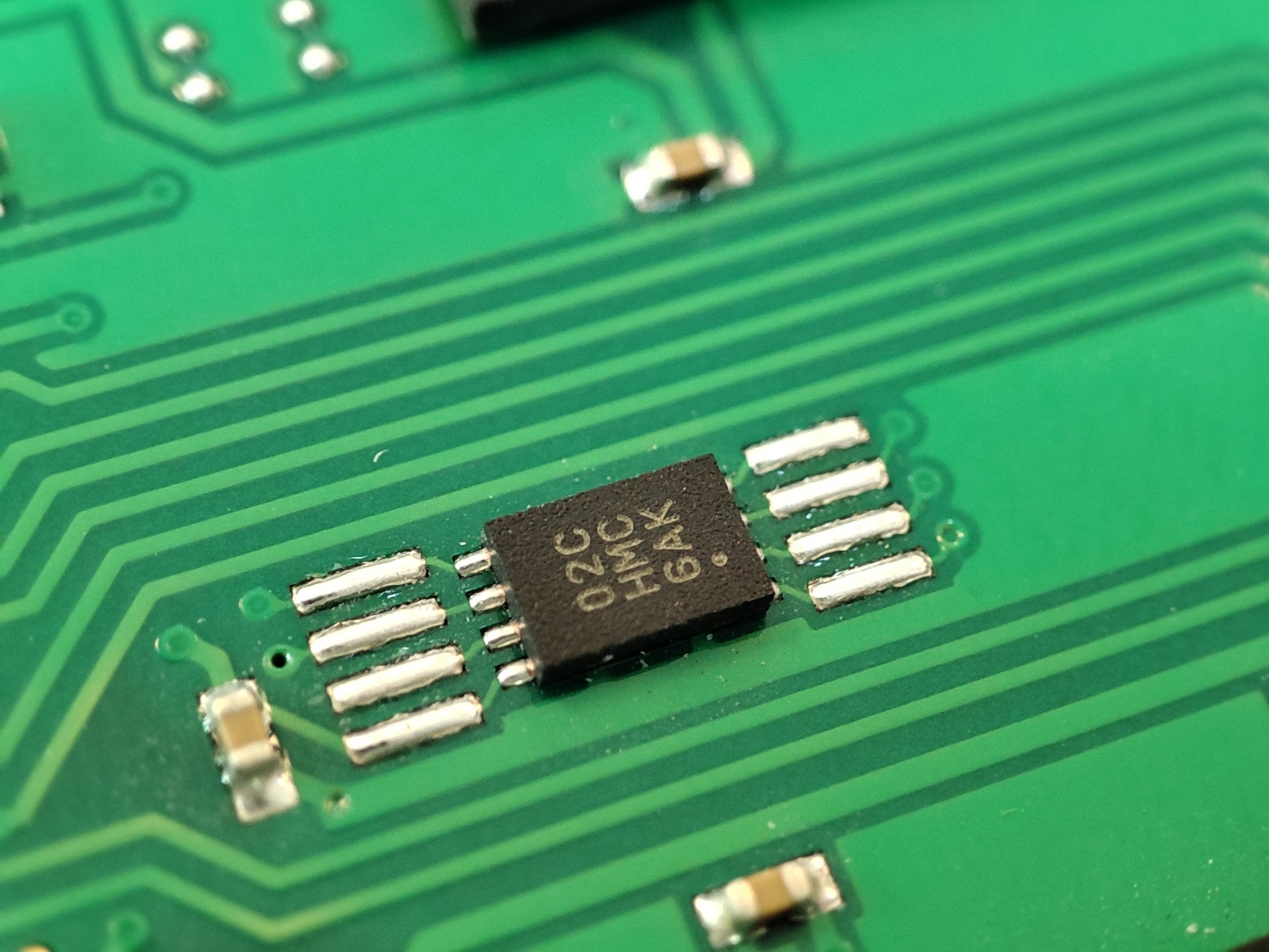
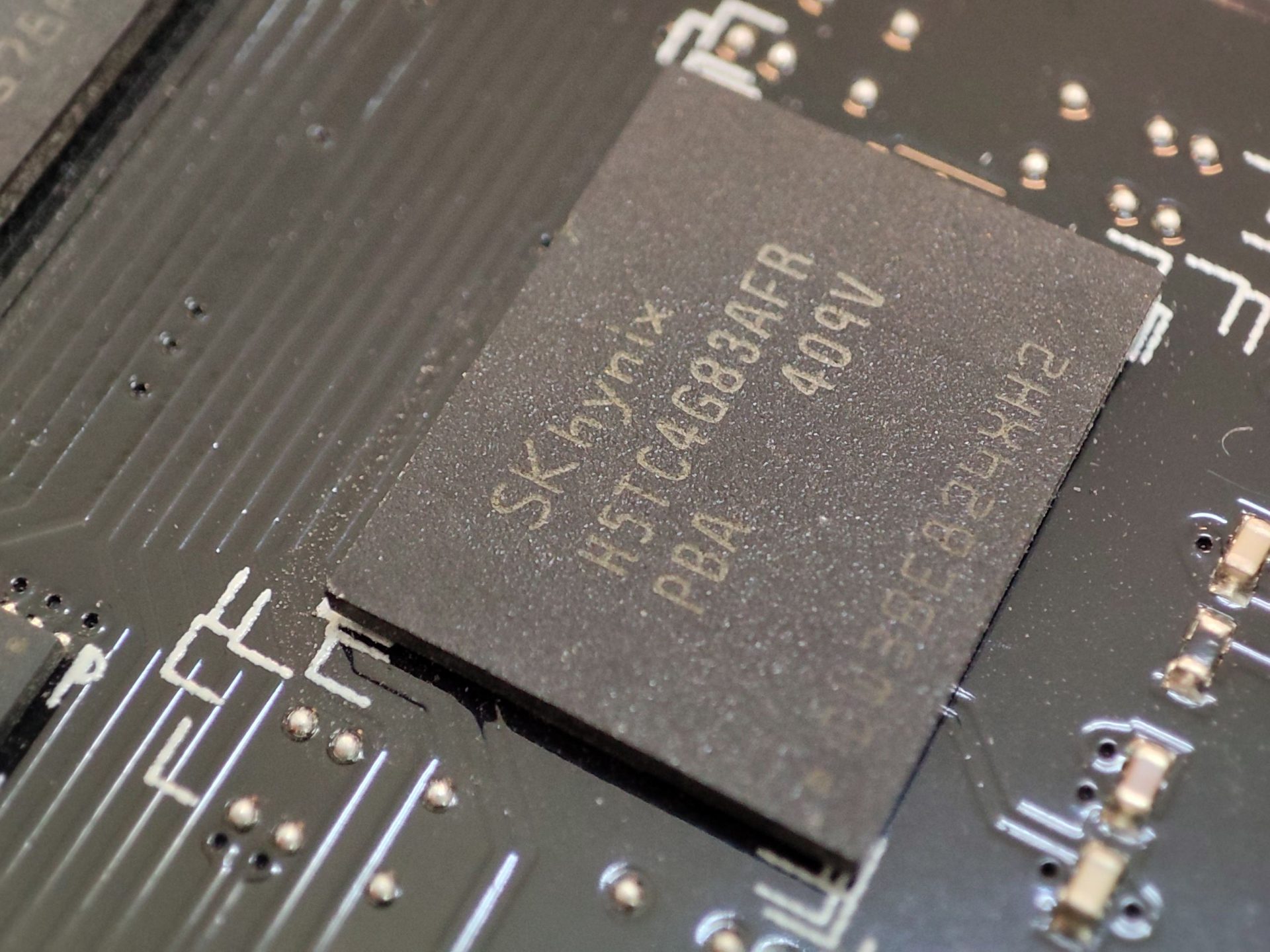
May 11i with the main camera can record 8K30, 4K30, and 4K60 videos; But the camera only shoots at 1080p30 resolution. Leaving aside the not-so-practical 8K video capability, the May 11I 4K videos are rated very well at about 50Mbps, both in detail, dynamic range, and contrast; But ultra. Still, ultraviolet is inching lower than the main camera in all areas.
Summary and comparison of Xiaomi Mi 11i with competitors
Xiaomi May 11i offers excellent processing power and performance in its price range, has one of the most accurate displays among all the smartphones we have ever reviewed, and also records high quality 4K videos; But apart from the mentioned cases, no significant feature can find in it to justify the price difference of 2 million Tomans with the Galaxy S20 FE 5G.
| Comparison | May 11 Xiaomi | Samsung Galaxy S20 FA 5G | May 11 Xiaomi | ||
|---|---|---|---|---|---|
| Supply | |||||
| Another letter | – Galaxy S20 Fan Edition – Galaxy S20 Lite | The Mi 11 is the Xiaomi Mi 11 Special Edition with 12GB of RAM and 256GB of storage. | |||
| Introduction | March 29, 2021 | 23 September 2020 | 28 December 2020 | ||
| Condition | Available, released May 31, 2021 | Available. Released on October 2, 2020 | Available. Released on January 1, 2021 | ||
| Display | |||||
| Type | Super AMOLED | Super AMOLED capacitive touch, 16 million colors | AMOLED, one billion colors | ||
| Dimensions | 6.67 inches (~ 85.9% screen-to-body ratio) | 6.5 inches (~ 85.7% screen to body ratio) | 6.81 inches (~ 91.4% screen-to-body ratio) | ||
| resolution | 1080 by 2400 pixels, 20: 9 (~ 395 pixels per inch pixel density) | 1080 by 2400 pixels, 20: 9 (~ 405 pixels per inch pixel density) | 1440 by 3200 pixels, 20: 9 (15 515 pixels per inch pixel density) | ||
| Bodyguard | Corning Gorilla Glass 5 | Corning Gorilla Glass 3 | Corning Gorilla Glass Victus | ||
| – 120Hz image refresh rate – Maximum brightness of 1300 nits – HDR10 + support | – HDR10 + – Always-on display – 120Hz image refresh rate | – HDR10 + – 120 Hz – 1500 nits brightness | |||
| Body | |||||
| Dimensions | 163.7 by 76.4 by 7.8 mm | 159.8 by 74.5 by 8.4 mm | 8.1 × 74.6 × 164.3 mm (8.6 mm thick if the back cover is leather) | ||
| Weight | 196 grams | 190 g | – 196 g (with glass back cover) – 194 g (with leather back cover) | ||
| Construction | Glass front (Gorilla Glass 3), plastic back, aluminum frame | Glass front (Gorilla Glass Victus), back glass (Gorilla Glass) or synthetic leather (Vegan), aluminum frame | |||
| IP53 certified for protection against dust and water spray | – Samsung P (Visa, MasterCard Certificate) – IP68 Certificate for water and dust resistance (up to 1.5 meters for 30 minutes) | ||||
| SIM card | Two SIM cards (nano-wire, one dual stand-by) | Single SIM card (nano-wire or eSIM or both) or dual hybrid SIM card (nano-wire, dual stand-by) | Two SIM cards (nano-wire, one dual stand-by) | ||
| Platform | |||||
| Operating system at the time of release | – Android 11 – MIUI 12 | – Android 10 – One UI 2.5 | – Android 11 – MIUI 12.5 | ||
| Chip | Qualcomm SM8350 Snapdragon 888 5G (five nanometers) | Qualcomm SM8250 Snapdragon 865 (seven nanometers +) | Qualcomm Snapdragon 888 (five nanometers) | ||
| CPU | 8 cores (one 2.84 GHz Kryo 680, three 2.42 GHz Kryo 680, and four 1.80 GHz Kryo 680) | 8-core (single-core 2.84 GHz Kryo 585 and three-core 2.42 GHz Kryo 585 and quad-core 1.8 GHz Kryo 585) | Eight-core (one 2.84 GHz Kryo 680 Prime (Cortex-X1), three 2.42 GHz Kryo 680 Gold, and four 1.80 GHz Kryo 680 Silver | ||
| GPU | Adreno 660 | Adreno 650 | Adreno 660 | ||
| Memory | |||||
| Memory port | No | microSDXC (using the second SIM card slot) | No | ||
| internal memory | 128 GB with 8 GB of RAM, 256 GB with 8 GB of RAM | 128 GB with 6 GB of RAM, 128 GB with 8 GB of RAM, 256 GB with 8 GB of RAM | 128 GB with 8 GB of RAM, 256 GB with 8 GB of RAM, 256 GB with 12 GB of RAM (Special Edition) | ||
| Memory type | UFS 3.1 | UFS 3.1 | UFS 3.1 | ||
| Camera | |||||
| Main | 108 megapixels (26mm wide-angle lens, 1 / 1.52-inch sensor size, 0.7 micrometer pixel size, phase-detection autofocus, f / 1.8) 8-megapixel (119-degree ultraviolet lens, f / 2.2) 5-megapixel (50 macro lens) Mm, 1 / 1.50 inch sensor size, 1.12 micrometer pixel size, f / 2.4) | 12-megapixel (26mm wide-angle lens, 1 / 1.76-inch sensor size, 1.8-micrometer pixel size, f / 1.8, dual-pixel autofocus with phase detection, optical image stabilization) 8-megapixel (73mm telephoto lens, size 1 / 4.5th , 1.0 micrometer pixel size, f / 2.0, phase detection autofocus, optical image stabilization, triple optical zoom) 12 megapixels (13mm ultraviolet lens with 123 degree coverage, 1 / 3.0 inch sensor size, 1.12 micrometer pixel size f / 2.2) | 108 megapixels (26mm wide-angle lens, 1 / 1.33-inch sensor size, 0.8 micrometer pixel size, f / 1.9, phase-detection autofocus, optical image stabilization) 13-megapixel (123-degree ultra-wide-angle lens, f / 2.4) 5 Megapixels (macro lens, f / 2.4) | ||
| Capabilities | LED flash, panorama, HDR | LED flash, panorama, HDR | Dual flash, panorama, HDR | ||
| Filming | 8K @ 30fps, 4K @ 30 / 60fps, 1080p @ 30/60/120/240 / 960fps, electronic image stabilization-gyroscopy, HDR10 + video recording | 4K @ 30 / 60fps, 1080p @ 30 / 60fps, electronic image stabilization-gyroscopy | 8K @ 24 / 30fps, 4K @ 30 / 60fps, 1080p @ 30/60/120/240 / 480fps; Electronic image stabilization-gyroscopic | ||
| Salafi | 20 megapixels (wide lens, 0.8 micrometer pixel size, 1 / 3.4 inch sensor size, f / 2.5) | 32 megapixels (26mm wide-angle lens, 1 / 2.74-inch sensor size, 0.8 micrometer pixel size, autofocus, f / 2.0) | 20 megapixels (27mm wide-angle lens, 0.8 micrometer pixel size, 1 / 3.4-inch sensor size) | ||
| Selfie filming | 1080p @ 30fps, 720p @ 120fps | 4K @ 30 / 60fps, 1080p @ 30 / 60fps, electronic image stabilization-gyroscopy | 1080p @ 30fps, 720p @ 120fps | ||
| Voice | |||||
| speaker | Yes, stereo speaker | Yes | Yes, with a stereo speaker developed in collaboration with Harman Kardon | ||
| 3.5 mm jack | No | No | No | ||
| 24 bit / 192 kHz sound | – 32-bit / 384 kHz sound – Adjusted by AKG | 24 bit / 192 kHz sound | |||
| Battery | |||||
| Battery | Non-replaceable lithium polymer battery with a capacity of 4520 mAh | Non-replaceable lithium polymer battery with a capacity of 4500 mAh | Non-replaceable lithium polymer battery with a capacity of 4600 mAh | ||
| Charging speed | – 33 watt fast charge (100% in 52 minutes) – Power Delivery 3.0 technology – Quick Charge 3+ technology | – 25-watt fast charge – 15-watt wireless charge – 4.5-watt reverse charge – USB Power Delivery 3.0 support | – 55 watt fast charge (100% in 45 minutes) – 50 watt wireless fast charge – 10 watt reverse charge – Power Delivery 3.0 support – + Quick Charge 4 support | ||
| Capabilities | |||||
| Sensors | Fingerprint sensor (next to the phone), accelerometer, gyroscope, proximity sensor, compass, color spectrum, barometer | Optical fingerprint sensor (below the display), accelerometer, gyroscope, proximity sensor, compass | Fingerprint sensor (sub-display, optical), accelerometer, gyroscope, proximity sensor, compass, IR Blaster sensor (remote control) | ||
| Bixby Voice Assistant with support for dialog voice commands | |||||
| Network | |||||
| Technology | GSM / HSPA / LTE / 5G | GSM / CDMA / HSPA / EVDO / LTE / 5G | GSM / CDMA / HSPA / EVDO / LTE / 5G | ||
| connections | |||||
| Wireless Network | Wi-Fi 802.11 a / b / g / n / ac / 6, dual band, Wi-Fi Direct, hotspot | Wi-Fi 802.11 a / b / g / n / ac / 6, dual band, Wi-Fi Direct, hotspot | Wi-Fi 802.11 a / b / g / n / ac / 6, dual band, Wi-Fi Direct, hotspot | ||
| Bluetooth | 5.2, A2DP, LE | 5.0, A2DP, LE | 5.2, A2DP, LE, aptX HD, aptX Adaptive | ||
| GPS | Yes, with dual-band A-GPS, GLONASS, BDS, GALILEO, QZSS, NavIC | Yes, with GLONASS, BDS, GALILEO, A-GPS | Yes, with dual-band A-GPS GLONASS, GALILEO, BDS, QZSS, NavIC | ||
| NFC | Yes (market dependent) | Yes | Yes | ||
| Radio | No | Radio FM | No | ||
| USB | – USB Type-C 2.0 – OTG support | Type-C 1.0 Reversible connector, OTG support | USB Type-C 2.0, OTG support | ||
| Infrared | Yes | _ | Yes | ||
| Other | |||||
| Colors | Silver, white, black | White, blue, orange, green, red, pink | Black, purple, white, blue, brown | ||
| models | SM-G781B | ||||
| Specific Absorption Rate (SAR) | – 0.95 watts per kilogram (head) – 0.74 watts per kilogram (body) | ||||
| Approximate price at the time of supply | About 650 euros | About 730 euros | About 700 euros | ||
Xiaomi’s flagship economy is by no means an inefficient phone, But it should note that its position is threatened by its flagship brother and the Galaxy S20 FE 5G. For a small fee, the user can buy the Xiaomi Mi 11 with the same chip, a much more enjoyable shooting experience, a spectacular 10-bit display, and a premium body, or for a smaller price, get the Samsung flagship with a slightly weaker chip and a more efficient camera.
Positive points
- OLED display with excellent brightness and accuracy
- Powerful Snapdragon 888 chip
- Good main camera performance during the day
Cons
- Medium charge
- Overheating
- Lack of wireless charging











